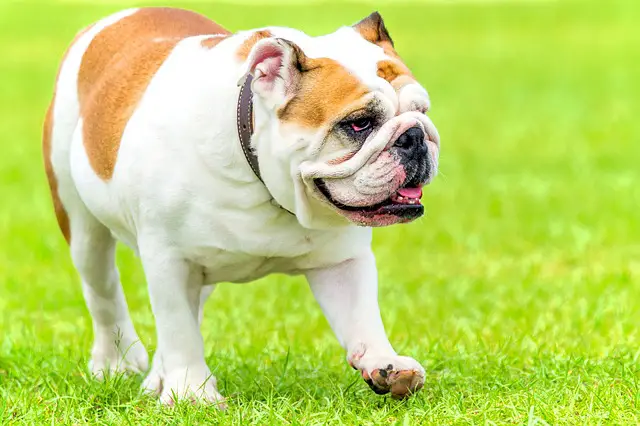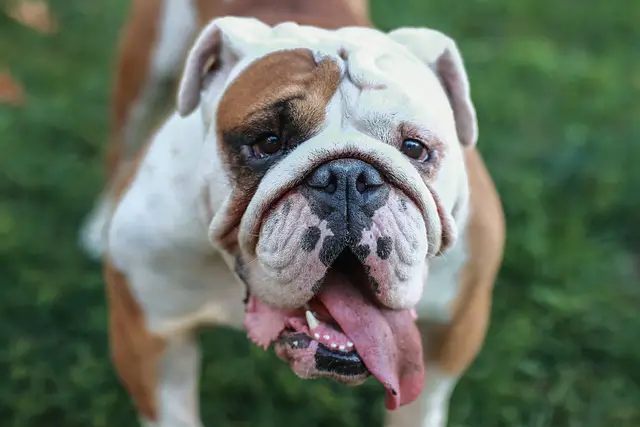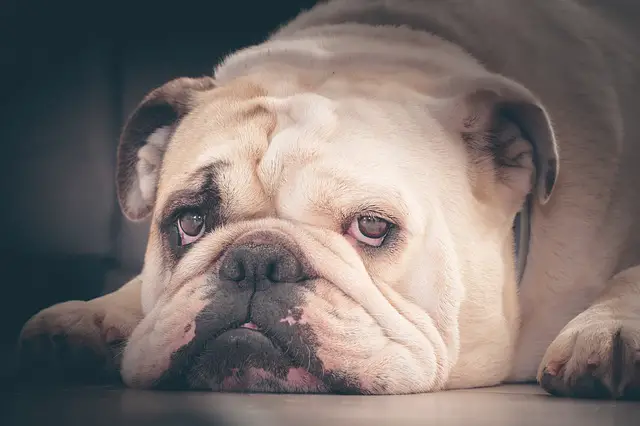Tearing is common among canines. But if you’re dealing with English Bulldog excessive tearing, something might be wrong. Increased eye discharge among Bulldogs can be a symptom of an allergic reaction, infection, trauma, obstructed tear glands, and more. In this post, I will discuss these possibilities and what you need to do to help your dog.
Causes of English Bulldog excessive tearing
If your English Bulldog is suffering from excessive tearing, you should rule out these potential reasons:
1. Breed
Breed-predisposed tearing is one of the most common problems among English Bulldogs. Brachycephalic breeds like Pugs, French Bulldogs, Maltese, and Bulldogs are prone to this eye problem.
This is because excess moisture can accumulate on their facial folds, which allows the proliferation of bacteria. If not cleaned well, this bacterial growth can irritate the eyes and cause further tearing.
2. Allergy

If dirty facial folds aren’t the problem, the potential cause of excessive tearing might be an allergic reaction. Food and environmental allergies can both trigger watery eyes on dogs.
Aside from excessive tearing, dogs suffering from allergies will also experience vomiting, diarrhea, and itchy skin. Over time, your English Bulldog will also try to paw its eyes to alleviate the discomfort, which will make tearing worse.
In some cases, a Bulldog with allergies will also have inflammation around the eyes. Sneezing and squinting will also occur, depending on what triggered the reaction.
English Bulldogs with a history of sensitivity will likely suffer from allergies because of the following:
- Insect bites
- Artificial food additives
- Excessive dust
- Increased pollen levels
- Specific food protein sources
It’s important to bring your English Bulldog to the vet’s clinic for a proper diagnosis. Aside from a thorough eye examination, your dog will also undergo RAST testing or intradermal skin testing.
With RAST or radioallergosorbent testing, the vet will conduct blood work to check for IgE antibodies and how it reacts to specific allergens.
On the other hand, intradermal skin testing placing a small amount of allergens under your dog’s skin. It’s just a pinprick so that it will hurt less than blood work. With this test, the vet will see which allergen will cause hives, which indicates an allergic reaction.
3. Eye infection
Another common cause of excessive tearing in English Bulldogs is an eye infection. This is quite an umbrella term for any bacteria, viral, or fungal causes that may trigger eye irritations.
Conjunctivitis is the most common form of eye infection among canines. It occurs when the thin mucous membrane of the eye (conjunctiva) becomes swollen. This condition can be triggered by a slew of causes, including allergies or external irritants.
Canines suffering from eye infections will often squint, blink excessively, and become light-sensitive. Aside from tearing, there will also be smelly and colored discharge coming from the eyes.
On the other hand, eye infections and excessive tearing in Bulldogs can also occur due to the following:
- Canine influenza
- Distemper
- Herpes
- Tick-borne diseases
- Leptospirosis
- Canine brucellosis
- Smoke exposure
- Getting shampoo in the eyes
- Fungal overgrowth
- Parasites
Eye infection is a multifaceted problem, so it’s always best to consult your dog’s veterinarian.
4. Obstructed tear glands

Obstruction of the lacrimal or tear glands will cause the tears to overflow. This might explain why English Bulldogs will experience excessive tearing. Aside from that, your dog will have a reddish tear stain.
In most cases of lacrimal duct obstruction, the lower nasolacrimal duct is often affected. This duct runs under the eye and along the snout of a canine.
So why is tear gland obstruction happening to dogs? First, it can be a genetic problem, which caused an anatomical defect in the tear ducts.
Tumors and foreign matter can also be culprits behind the obstructed tear glands of your English Bulldog.
It’s important to treat an obstructed lacrimal duct in dogs right away. If not, bacteria may start to grow in the moist area of the eyes. This will lead to further tearing and a full-fledged eye infection.
Moreover, treatments for an obstructed tear gland among English Bulldogs can be through oral medications or a surgical procedure.
5. Trauma or injury
Injury or trauma can also lead to English Bulldog excessive tearing. For example, if a sharp object pricked your dog’s eye, it will cause irritation. The response of the lacrimal glands is to produce more tears in an effort to cleanse or get rid of the irritant.
Trauma-related injury is very common among dogs, especially after a dog fight or rough play. It’s still best to bring your dog to the vet for proper examination. This is especially true if the excessive tearing, blinking, and squinting isn’t going away for days. Also, you should consider it an emergency if your dog’s eyes are already producing colored discharge.
6. Entropion

Entropion is a condition on which the eyelids of the canine roll inward. The likes of Akita, English Bulldog, Pug, Pekingese, and Pomeranians are just some of the most affected breeds.
Since the eyelids roll inward, the eyelashes scrape the outer layer of the eyeball. This will lead to excessive tearing, pain, inflammation, and a slew of infections if not addressed right away.
Over time, corneal ulcers will occur as a secondary condition to entropion (more on this below). An English Bulldog can suffer from blindness to the point that the affected eyeball needs to be removed. And unfortunately, entropion almost always affects both eyes at the same time.
This condition is inherited and can be treated through surgery, depending on the severity of the problem. Most of the time, the vet will conduct two surgical procedures to prevent overcorrection by allowing the first treatment to heal first.
Take note that overcorrection of entropion can lead to another problem called ectropion. This is where the eyelids roll outward too much, which can also lead to infections and excessive tearing.
7. Corneal ulcer
As mentioned, a corneal ulcer can be a secondary condition to severe cases of entropion. It can also be due to trauma like excessive eye rubbing on the carpet or a claw scratch from another animal. In rare cases, a corneal ulcer is developed due to a chemical burn.
Take note that corneal ulcers are unbearably painful, and affected English Bulldogs will keep pawing and rubbing their eyes to alleviate the discomfort. This will make the problem worse.
The problem with a corneal ulcer is it’s not readily visible in the naked eye, except for large ones. Veterinarians have to conduct tests using special stains like fluorescein. When dropped on the affected eye, the color will attach to the areas with ulcers.
However, if the ulceration of your English Bulldogs cornea is deep, the vet will need to take cell samples for further testing.
Depending on the extent of the abrasions, an English Bulldog’s ulcerated cornea can heal within a week through drops and ointments. But if the corneal ulcers are severe, surgery may be needed.
What to do if your Bulldog is tearing excessively
If you noticed that your English Bulldog is tearing excessively, the first thing to do is manage the discharge. Wipe it regularly but gently to avoid moisture build-up on your Bulldog’s facial folds.
Also, it’s important to note the color and odor of your Bulldog’s eye discharge. The following are the most common eye discharge among canines and what it potentially means:
- Watery discharge. It’s often triggered by foreign objects like eyelashes getting into your dog’s eyes.
- Yellow-green discharge. This eye discharge is indicative of a serious infection. You must call the vet right away.
- Reddish discharge. A reddish eye discharge is one of the tell-tale signs of obstructed tear ducts. However, it can also indicate cuts or wounds.
I always recommend seeking veterinary care if your Bulldog’s excessive tearing isn’t subsiding. Take note that most causes of watery eyes can be treated only if diagnosed early.
Never attempt to self-medicate your Bulldog using eye drops or contact solutions made for humans. This can cause further irritations, which can potentially blind your pet.
While vet visits cost a fee, it might cost your pocket more once your dog suffers adverse reactions from your home remedies.
How to prevent excessive tearing in English Bulldogs
Many causes of excessive tearing in dogs can be prevented through the following tips:

- Always keep their face clean. English Bulldogs have a wrinkly face that makes a perfect breeding ground for bacteria. With this, make sure that you wipe and their face dry as much as possible. Pay close attention to the folds under and near the eyes.
- Ask the vet for eye solutions. Upon examination, the vet can prescribe an eye drop solution to your dog. This is to prevent irritations or infections due to tearing.
- Prevent dog fights. If you have multiple pets at home, try to keep a calm environment to prevent dog fights. Pet fights often lead to pawing and clawing of the face, which can injure the eyes.
- Put your pet on a dog cone. If your English Bulldog is currently undergoing treatment for eye problems, it’s best to keep him wearing a cone or lampshade collar. This is to prevent pawing or scratching of the eyes, which will sabotage the ongoing treatment.
- Be careful while bathing. During grooming time, be careful not to get shampoo into your Bulldog’s eyes. If your dog is quite fidgety, I suggest using a no-tear canine formula to prevent eye irritations.
- Rule out allergies. If you suspect that your Bulldog’s excessive tearing is due to allergies, you should have it checked first. From there, you can make lifestyle changes for your dog, like switching to a new dog food formula or avoiding specific products.
- Use the right tear stain remover. When it comes to tear stains, always look for gentle and dog-safe solutions. It’s best to ask your dog’s vet instead of buying just about any cleaner in the market.
Frequently Asked Questions
Q: How much is a tear duct surgery in dogs?
A: Surgical procedures to correct tear duct problems in dogs can cost around $500 to $1,500 for each duct. However, this cost can skyrocket with the addition of medication, added tests, and other recovery-related procedures.
Q: Is Visine safe for dogs?
A: Visine isn’t FDA-approved and not vet-advised to be used on dogs. It’s best to consult your dog’s veterinarian when it comes to your pet’s eye problems. Self-medicating your dog may lead to further problems, which will cost more in vet bills in the long run.
Q: Why do my dog’s eyes water when eating?
A: Food intolerance is one of the reasons why some dogs tend to have watery eyes while eating. However, you should also check for chemicals emanating from the food, which could be stinging the eyes. Other eye problems can also be a reason, wherein the symptoms coincided while your pet is eating.
Q: Is it normal for puppies to have watery eyes?
A: Lingering watery eyes on puppies are not normal. Your pup might be suffering from eye irritations or underlying health problems. The vet is always the best person to call for proper diagnosis and treatment.
Q: How can I treat my dog’s eye infection without going to the vet?
A: Some dog eye infections are minor and can be treated at home using over-the-counter medications. However, most home remedies only offer temporary solutions, especially if the eye infection is already advanced. Always consider what’s best for your dog and consult a vet instead.
Final words
English Bulldog excessive tearing must be addressed right away to get to the root of the problem. With early diagnosis, your pet will be saved from further discomfort, especially if it’s suffering from corneal ulcers, entropion, injury, or obstructed tear ducts.
Whatever the cause of your dog’s abnormal tearing, the vet is always the best person to call. As much as possible, fight the urge to self-medicate your dog without consulting a professional.
In case of foul-smelling eye discharge, it’s best to bring your dog to the vet’s clinic because it indicates a serious problem.
Have you encountered excessive tearing with your dog before? How did you handle it? Share your thoughts below!

